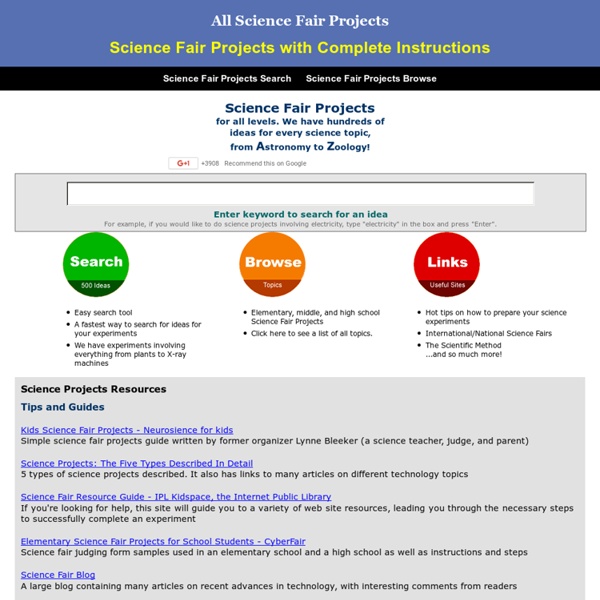Distance, Velocity and Time: Equations and Relationship
Do you remember the story of the tortoise and the hare? The tortoise and the hare decided to have a race. Everybody, most of all the hare, thought the hare would win the race because he hopped much faster than the tortoise plodded. We could say that the hare usually travelled at a much higher velocity than the tortoise. Velocity is the measure of the amount of distance an object covers in a given amount of time.
Math Trainer - Times Tables
Get in some serious math training. Responds to your answers, so it trains your weaknesses. Train yourself to remember, don't count (the cutoff time helps with this) New Version! (Note: the old version is here.) Features of the Math Trainer
Choosing a Light Bulb Filament
Grade Level: 8th – 10th; Type: Physics In this experiment, you will create your own light bulb and test filaments of different thicknesses to see which keeps the bulb burning for the longest time. How can you make a light bulb burn for as long as possible? Which thickness of filaments is ideal for a burning light bulb?
DISCOVERY: A Simulation of Early American Colonization - Interact Simulations
Divided into separate "colonies," teams of students face problems typical of life in 17th-century America and try to ensure the success of their settlements. After deciding on cargo and using map skills to cross the sea and select their sites, students—playing such roles as colony leaders, bankers, mappers, traders, and recorders—are pressed to make decisions concerning the division of labor, the role of government, and defense against possible Indian attack. Interaction among the colonies results in trading, alliances, and sometimes conflict, while Fate Cards affect each colony's success or failure. The wealthiest colony after 15 rounds of play wins. The simulation may run for as many as 19 class periods, but can be truncated greatly depending on class skill level and time available.
How to Find Maximum Height of a Projectile
Ever wanted to know how high and how fast you can kick a football? Turns out, it’s pretty easy to figure out. All you need to know is how far away from you the ball lands and how much time it spends in the air (the “hang time”).
The World Factbook
People from nearly every country share information with CIA, and new individuals contact us daily. If you have information you think might interest CIA due to our foreign intelligence collection mission, there are many ways to reach us. If you know of an imminent threat to a location inside the U.S., immediately contact your local law enforcement or FBI Field Office. For threats outside the U.S., contact CIA or go to a U.S. Embassy or Consulate and ask for the information to be passed to a U.S. official. Please know, CIA does not engage in law enforcement.
A Plasma Ball! What is it and How Does it Work?
Grade Level: 6th - 9th; Type: Physics To determine what a plasma ball is and how it works. What is plasma? What are ions? What are inert gases? What is the Tesla coil and how is it used?
Representation of Different Types of Motion by Simple Graphs
In the previous experiment, we worked with constant velocity in one direction and found that the motion was represented by simple graphs whose slopes were straight lines. Here, you study the motion of a person going forward and back, fast and slow. You also measure the effect of speeding up and slowing down.
Air Resistance > Experiment #13 from Physics with Vernier
Recommended for High School. Loaded: 0% Progress: 0%
ELATE
This activity is about velocity, acceleration, and deceleration,as influenced by forces of friction and gravitation. And you will be introduced to a device called a ticker-timer. At the end of the activity, the learner should be able to: Describe how friction compensation happens on a runway.
Newton's 3 Laws of Motion
Problem: Does height of a ramp affect the distance a hot wheels car will travel? Hypothesis: I think that ... because ... Materials: one meter ramp hot wheels car meter stick 4 science books science journal and pencil Procedure: Build the ramp one science book high.
Lemon "Juice" > Experiment #17 from Middle School Science with Vernier
Recommended for Elementary through High School. Loaded: 0% Progress: 0% Introduction
schoolphysics
Sample Creative Teaching Ideas Convection and a tea bag This is a fun experiment to demonstrate convection especially if you use the £10 note!
The resourceful physics teacher
Physics teacher Keith Gibbs shares some of his many demonstrations and experiments for the physics classroom. During more than 30 years of teaching physics, I have come across many interesting demonstrations and teaching ideas – often suggested by relatives, friends, colleagues and past students. In 2000, I began to gather these ideas together – this was the basis of the Schoolphysics website and CD-ROM collection. Over time, I added more explanation and background for teachers whose specialism was not physics. Below are four ideas from the collection.



